-
Car Reviews
- All reviews
- Midsize SUVs
- Small cars
- Utes
- Small SUVs
- Large SUVs
- Large cars
- Sports SUVs
- Sports cars
- Vans
Latest reviews
- Car News
-
Car Comparisons
Latest comparisons
- Chasing Deals
Lexus takes a huge swing at the new Prado platform with the new GX off-roader – and, with few exceptions, the rugged yet refined result is a home run
In bringing the rugged, Toyota Prado-sized GX to Australia for the first time, Lexus has solved one big problem – but it’s left another issue on the table to (perhaps) fix later.
Good news first: releasing the GX shows Lexus has discovered its charisma. Just look at the thing: the styling is unashamedly square, muscular, and confident – and yet yet somehow not alarmingly aggressive in execution like so many large vehicles. The Lexus GX is obviously cool. It doesn’t need to shout about it.
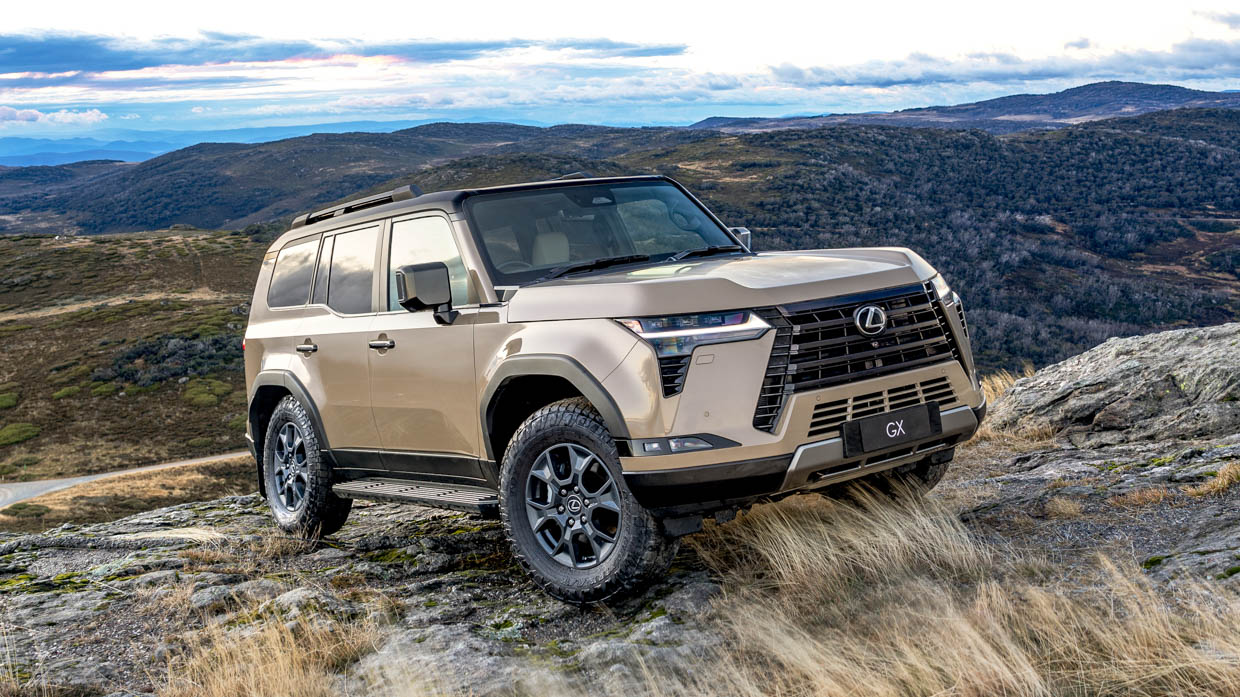
Bad news? Well…the GX is supposed to fill two roles in Australia. First, it adds the GX as a second serious 4WD (with body-on-frame construction and low-range transfer case) to the Lexus lineup for buyers that crave authenticity in their SUV.
But it’s also the replacement, of sorts, for the departed RX L seven-seat SUV – in other words, Lexus’s only halfway-justifiable three-row vehicle. The larger LX does have a wayback row, but it starts at $155,976.
The issue is that by making the GX a true four-wheel drive, mechanically dedicated to taking on genuinely difficult terrain, the space left over for the third row is frankly tiny. As a result, Lexus just does not have an answer to the likes of the Audi Q7 or Volvo XC90.
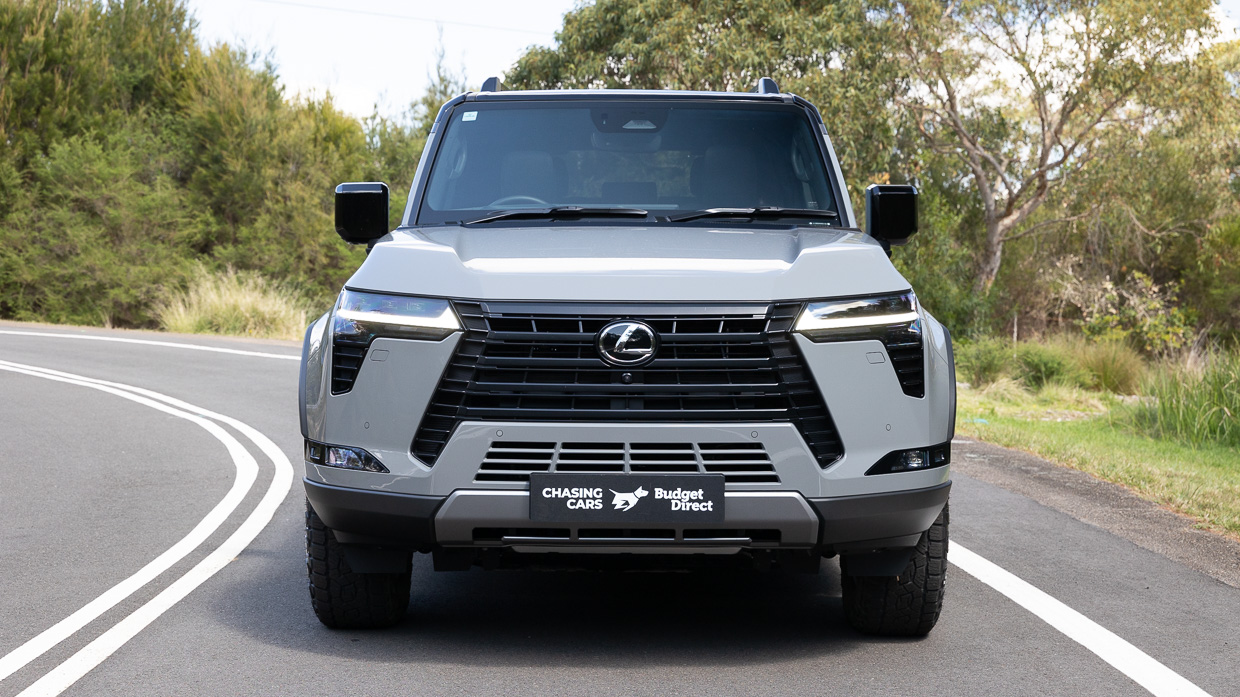
Which is why it’s refreshing, in a way – or at least honest – that the coolest-looking GX, the Overtrail trim on test, doesn’t even pretend to offer a third row. The most dialled-in version of the new Lexus, with extreme out-of-the-box capability, is a dedicated five-seat vehicle.
And it’s just landed in Australia, ready for testing on local roads and trails. Priced at $122,250 list (or about $139,000 driveaway as tested in two-tone paint), it slots into direct contention against the likes of the Land Rover Defender – or a larger, but lower-end, Land Cruiser 300 Series.
Sharing many of its 250 Series underpinnings with the forthcoming, as-yet unreleased Toyota Prado, the GX offers Land Cruiser faithful an interesting alternative that uses a beefy turbocharged V6 powertrain (easily eclipsing a Prado diesel), yet in a considerably more wieldy size than the six-cylinder 300 Series and LX models.
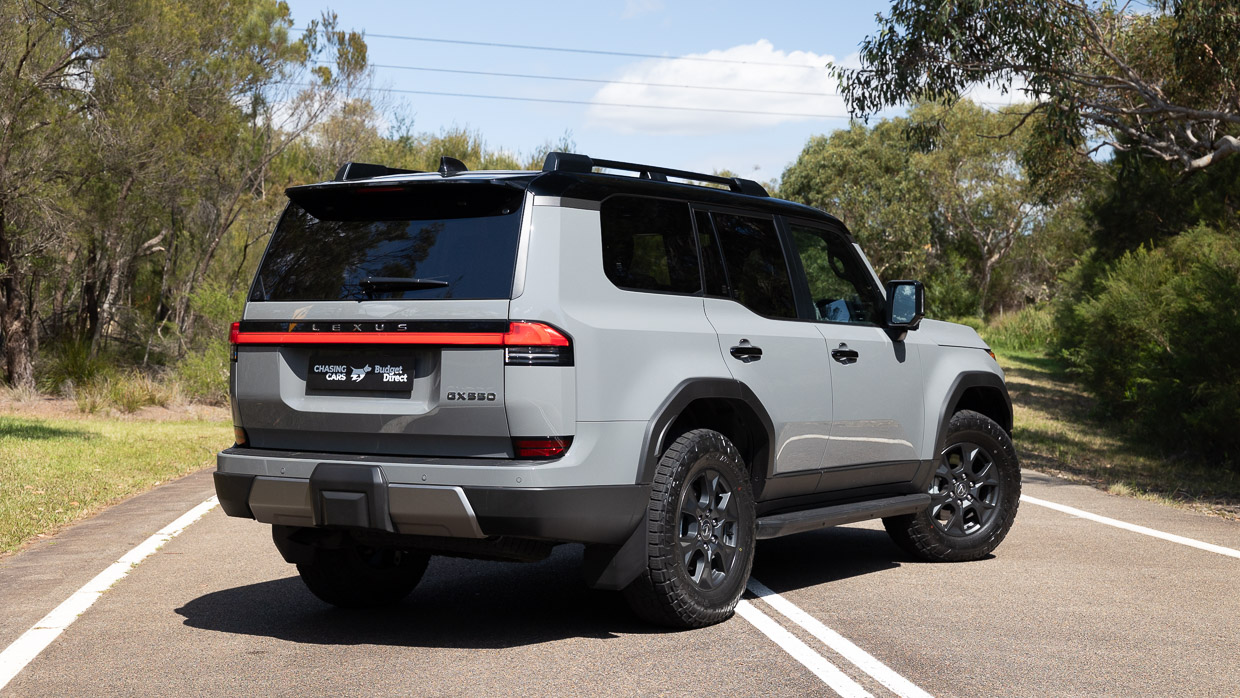
This isn’t our first meeting with GX: we drove a prototype near Mt Fuji, Japan, and then a production US-market car in the Sonora Desert of Arizona, USA. But there is no substitute to a full test, in right-hand-drive form, on Australian terrain. And it just so happens that the GX shone brighter locally than it did in either foreign environment.
So, who should consider the GX, and why do we think this vehicle is one of the strongest Lexus releases in many years? Read on…
First, it’s important to put the pricing of the Lexus GX in context. While no version of the new model is ‘cheap’, the GX has clearly been positioned to create a ‘bridge’ between high-end Prados and either a posh Land Cruiser 300 Series or a base model Lexus LX.
Consider the following list of vehicles from this segment and those around it:
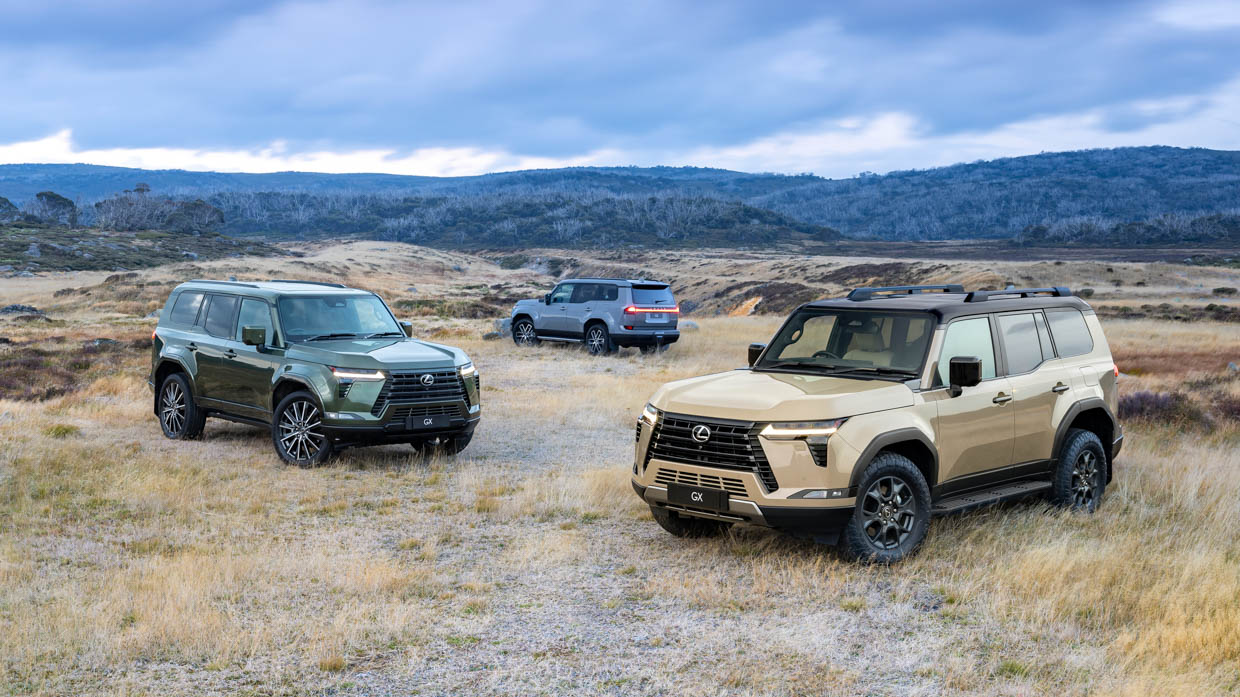
I’ll also point out that some buyers might also cross-shop the GX – as one of the large Lexus SUVs – against some car-based options that have significantly less hardcore off-road capability but superior on-road manners:
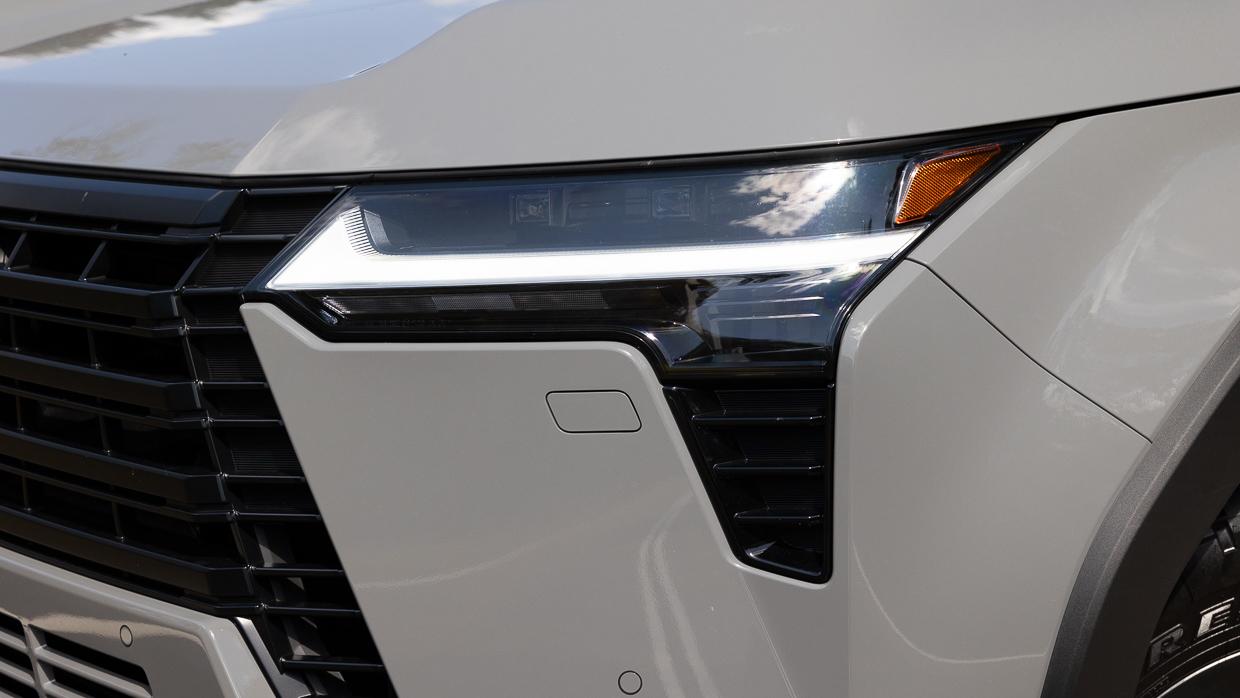
So, with the GX550 Overtrail on test, what are you getting for your circa-$134,000 driveaway? Here’s what is standard:
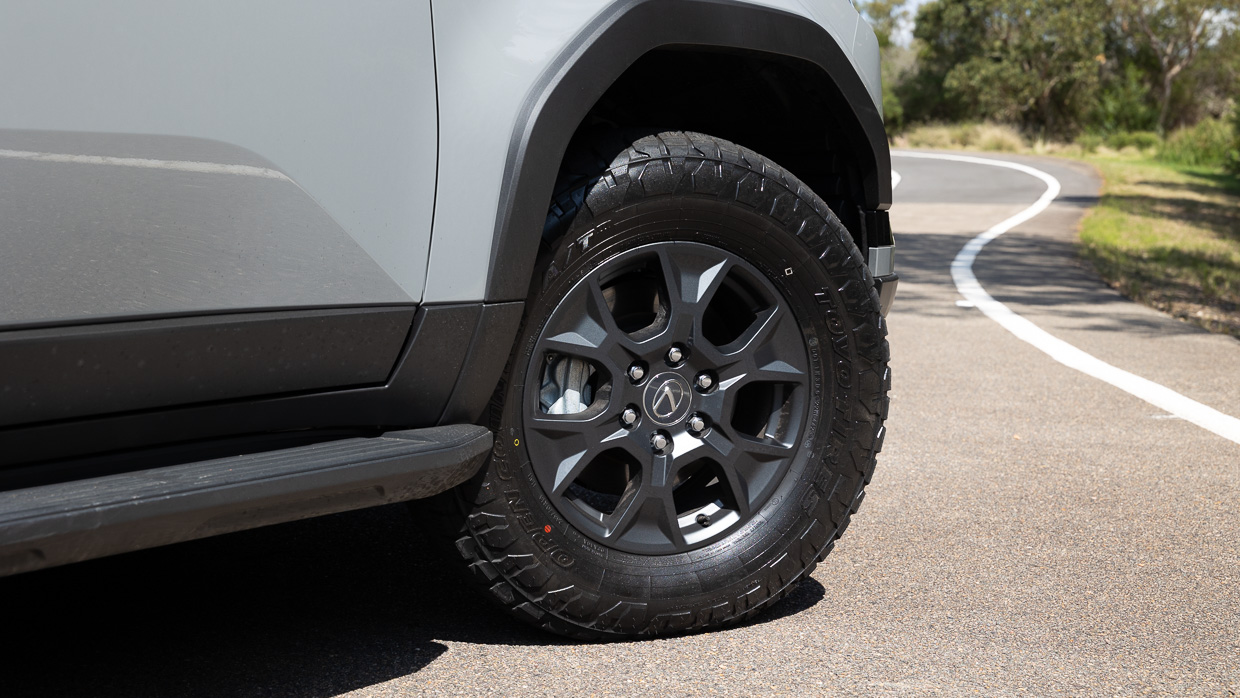
Over and above the approximately $6000-cheaper (on-road) Luxury grade, the Overtrail gains very little in the way of convenience spec. But the upgrade price is actually a bargain if you’ll get use out of the dedicated off-roading mechanical upgrades (tyres, locking rear diff, eKDSS, et cetera) or, of course, if you simply think it looks cool.
Spending $7000 more on the Sports Luxury loses the Overtrail’s off-road obviousness, reverting to more luxurious styling. Upgraders nab 22-inch multi-spoke alloys, power side steps, semi-aniline leather trim, massaging front seats, 21-speaker Mark Levinson premium stereo, a digital rear view mirror, heated steering wheel and a fixed panoramic glass roof.
The sole extra for the Overtrail on test is colour. Graphite Black solid paint is included, but other hues attract a premium: $1750 for Sonic Quartz (white) with matching roof, or a hefty $4200 for the remaining colours which exclusively fit a contrast black roof: Titanium Carbide (flat grey), Titanium (silver), Khaki Metal (green), or Moon Desert (sand beige).
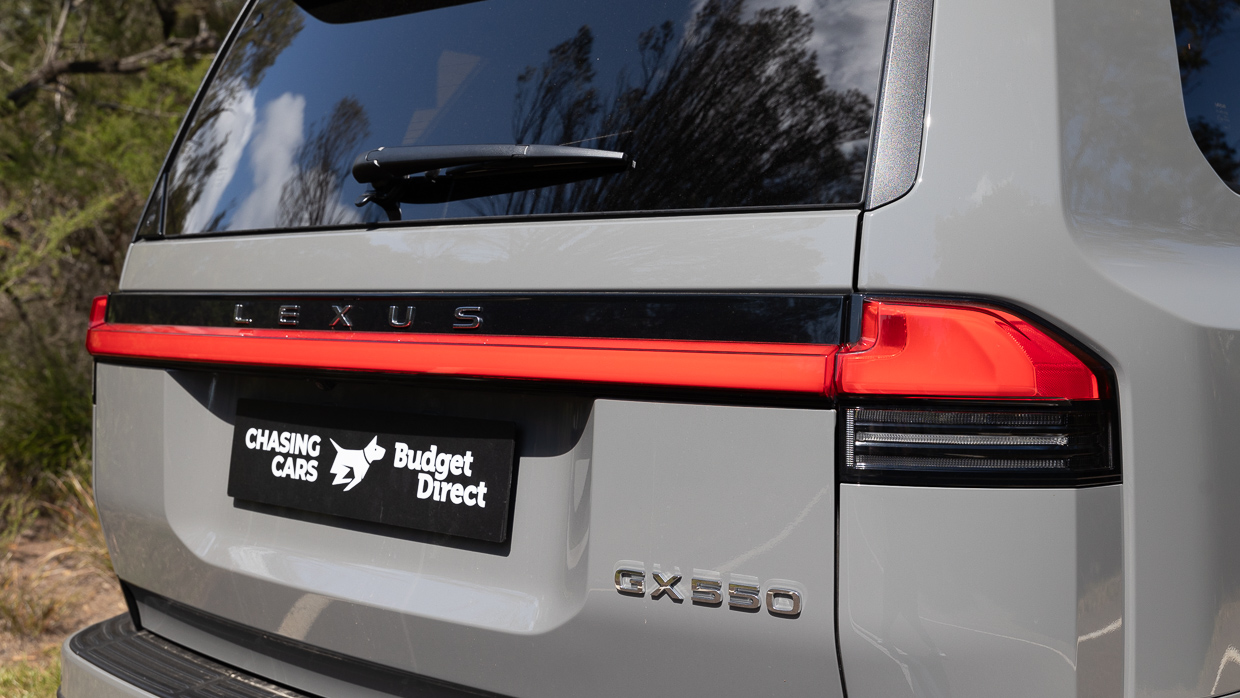
Inside, you also have to choose, at no additional cost, a seat upholstery colour. Black ‘Nuluxe’ trimming (with subtle olive green Ultrasuede highlights) is standard, with a choice of Tsuyasumi charcoal film trim or oak wood. Alternatively, buyers can opt for a ‘Chateau’ colour (black and sand two-tone) with Tsuyasumi trim.
For our money, we actually think the Overtrail is the sweet spot. Aesthetically, it delivers on the GX’s promise of rugged luxury – and it’s genuinely capable when the going gets very rough, too. For the modest step up from the Luxury, it makes sense. We’d go Khaki Metal or Moon Desert over Chateau.
There’s something about the way the GX550 drives that is viscerally appealing. After a week of testing, we think it’s the blend of the GX’s commanding driving position, generous grunt, and handling that is easier and more polished than what drivers can normally expect from frame-based 4WDs.
First, there’s the sensation that you can really see out of this vehicle. Unlike so many modern SUVs, this rig doesn’t give any quarter to curvy, aerodynamic styling that compromises visibility. It’s a large box, with a lot of glass. You sit high, with low window sills, like an old-school Range Rover. It’s a king-of-the-road mindset up here.
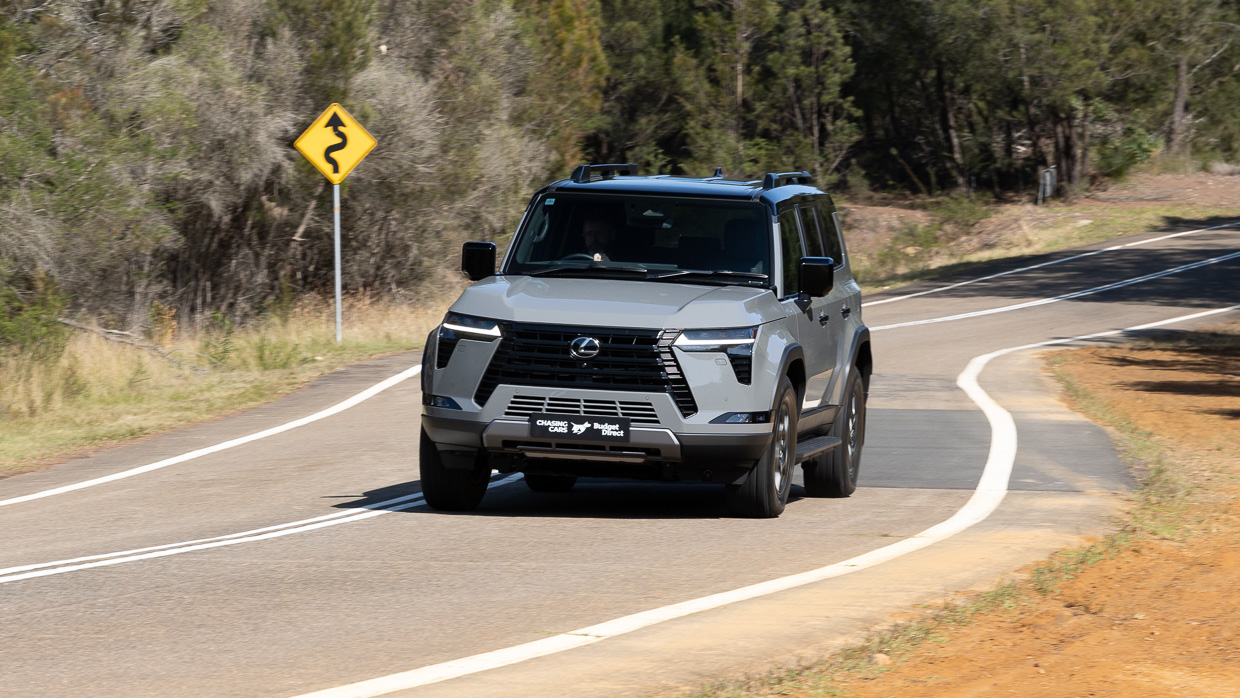
Narrow and tall mirrors aside (you get used to their field of view), the GX is immediately refreshing in its conventional design. And it’s pragmatic: looking ahead, two bulges appear at the outer edge of the bonnet. Those bulges perfectly line up with the tyre width, so you know precisely where you’re putting your wheels. Thoughtful.
Beneath that bonnet is the source of considerable envy for new Land Cruiser Prado buyers: massive delineation exists between the Toyota and Lexus interpretations of this chassis.
While the Prado soldiers on with a 2.8-litre turbo diesel four-cylinder making 150kW/500Nm, the GX nabs a 3.4-litre twin-turbo petrol V6 with 260kW/650Nm! (Yes, at 3445cc, Lexus rounds up to 3.5L in marketing.)
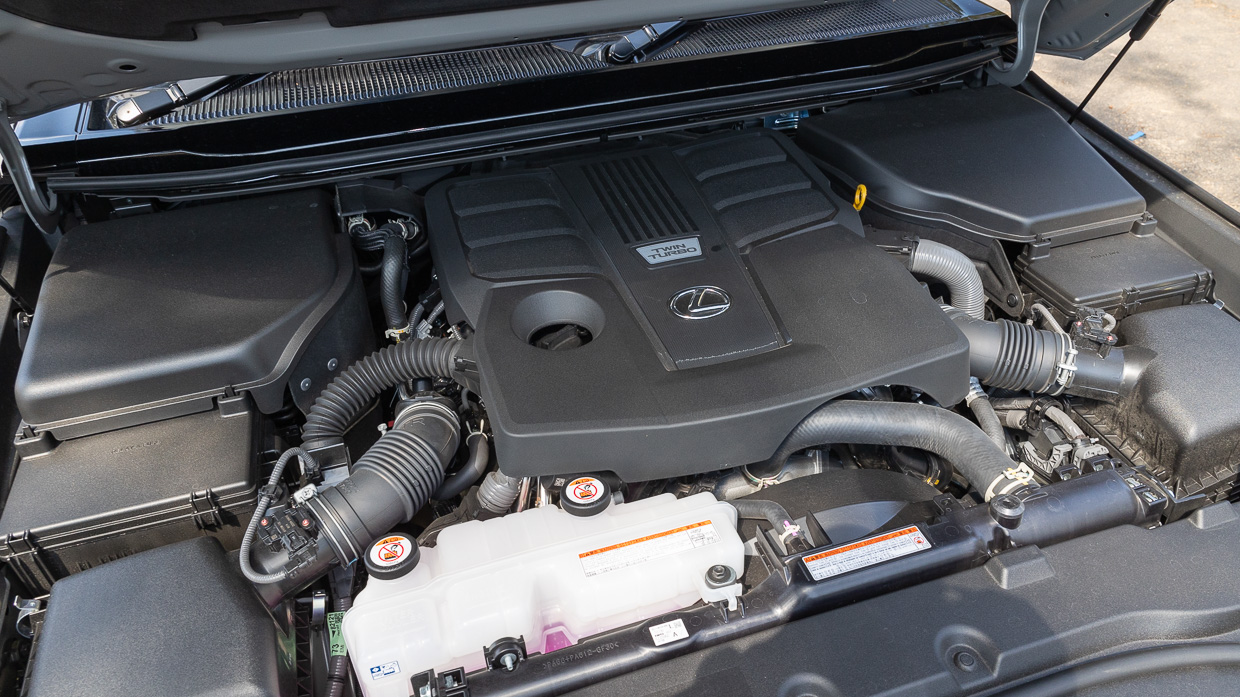
We haven’t yet tested the new Prado, but its diesel ‘four is a carryover (aside from a new mild-hybrid system). Based on our experience of that unit, we can picture how back-to-back test drive of a Prado Kakadu ($99,990) and, say, an entry-level GX Luxury ($116,000) will go. We suspect many will smash the piggy bank to find an extra $16K!
Our suspicions are grounded as much in data as they are in seat-of-the-pants feel. Chasing Cars performance-tested the GX550 Overtrail and determined its 0-100km/h time to be 6.24 seconds – at least four seconds quicker than the Prado. And keep in mind, that’s on Toyo Open Country all-terrain tyres, not the street tyres you get on other trims.
Out on the road, grunt is never lacking. Despite the GX’s boxy shape, bury your right foot on the loud pedal and the GX550’s 10-speed automatic transmission promptly finds a lower gear and runs – making a pleasant (but muffled) roar as it does so. Merging onto fast-moving highway or overtaking B-doubles is a stress-free experience.
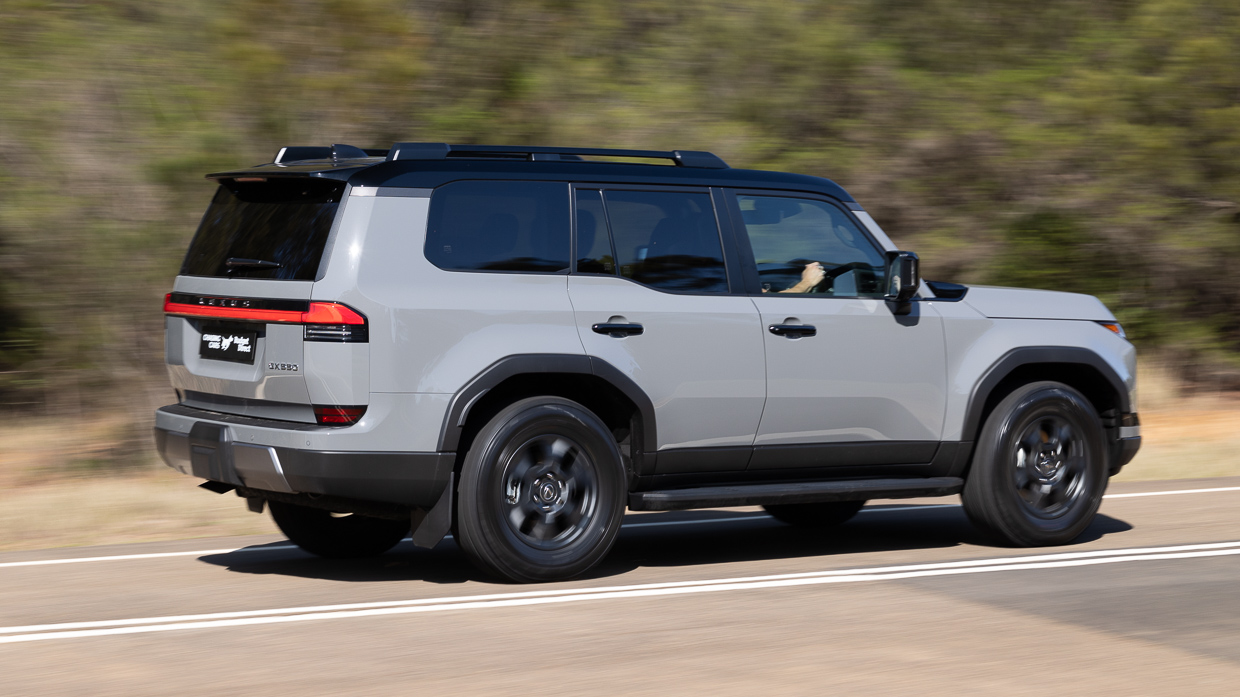
We know not to look gift horses in the mouth, but we suspect the 3.3-litre twin-turbocharged V6 diesel fitted to the LX500d (and 300 Series Land Cruiser), making 227kW/700Nm, would be an even better fit in the GX.
Having good performance on-call is one of the reasons the petrol V6 GX makes for an effortless country tourer. Aside from some wind whistle around the upright mirrors, it’s a pretty refined experience…aside from the fact you have to stop far more frequently than you should (as discussed in the Ownership Costs segment below).
When we tested the GX in Arizona, we had concerns about the ride quality. Those worries dissipated to some degree back on Australian roads. While the GX exhibits some typical ‘fidget’ associated with frame-based wagons, it isn’t to a frustrating degree, and within a few days, you’re used to the subtle pitter-patter over road imperfections.
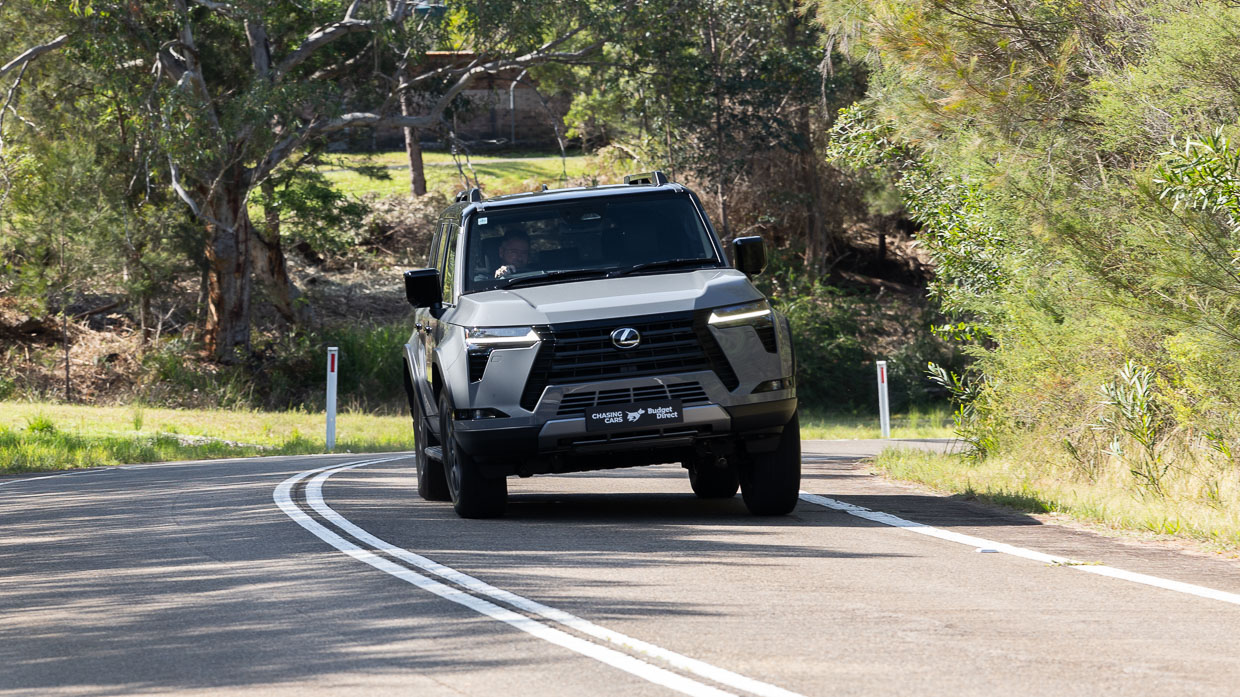
The compliance is never going to be in league with car-based SUVs like the Audi Q7, BMW X5 or Volvo XC90 (or even the unibody-construction Land Rover Defender) but for a serious 4WD, it’s pretty decent – we think it’s better than the larger and considerably more expensive LX, in fact.
So’s the steering: it’s clear that Lexus has put considerable development effort into getting the steering to feel remarkably car-like, and the fitment of a small-diameter steering wheel enhances the psychological effect. There is expected body lean in the corners, but on the whole, the GX handles crisply and can even be hustled along B-roads in a prompt manner.
Mechanically, the GX has coil springs all-round with a double wishbone independent front suspension and a five-link solid rear axle. The Overtrail trim goes further, adding valved, adaptive variable shock absorbers and Toyota’s e-KDSS system that electronically adjusts the GX’s sway bars to situationally limit body roll, or enhance wheel articulation.

The fitment of e-KDSS is becoming increasingly rare in any Toyota Motor Corporation vehicle: no new Prado has it, for instance, while only the very top trims of the full-fat Land Cruiser 300 Series fit the tech locally – the GX550 Overtrail becomes the most affordable way to access e-KDSS in a brand-new vehicle.
The GX’s off-roading specs are decent. I’ve tackled tough obstacles in the vehicle (including gnarly moguls to demonstrate e-KDSS). But there is room for improvement: 225mm ground clearance trails a Defender’s air-sprung 290mm max. Wading depth is 700mm; the approach angle is 26 degrees, breakover 24 degrees, and departure 22 degrees.
There is immediate cohesion between the squared-off exterior aesthetic of the GX and the construction of the interior, which echoes the external forms with an almost eighties-style rectangular dash layout. It isn’t quite retro, but it certainly echoes memorable four-wheel-drive styling of decades gone by.
It’s similar to the forthcoming new Prado in that way, but the pair have been executed with many differences – and there is significant differentiation to the GX interior, with only hints of shared hard points and similarities in the infotainment system’s layout and look. Lexus fits its own seats, cabin materials, knobs, switches, dials, controls and more.
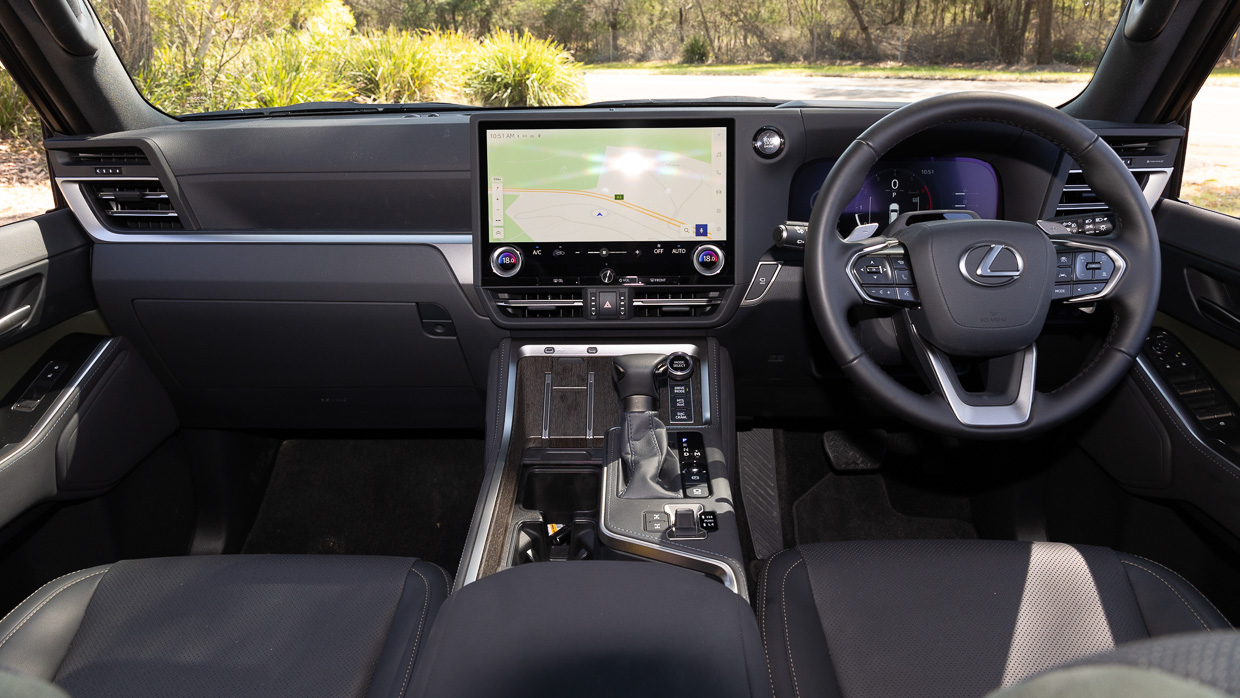
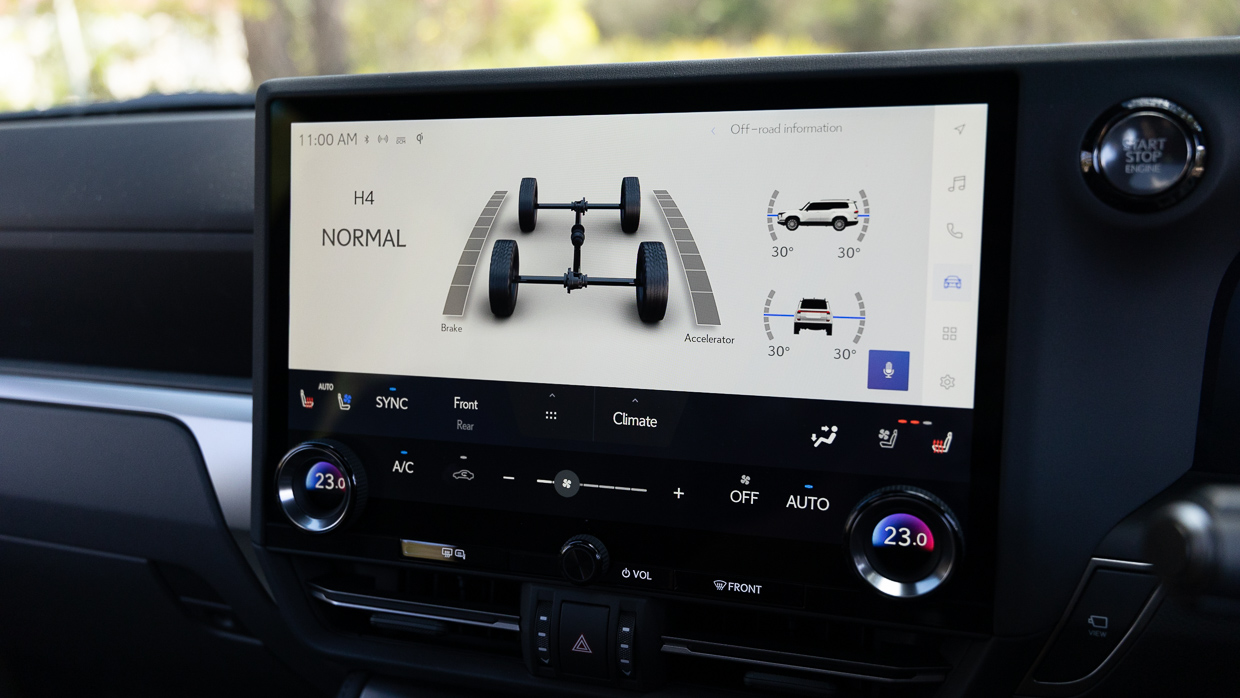
You climb up into a GX, assisted by its side running boards. It’s a very high seating position (affording great visibility on the road), with the dashboard and door sills sitting lower than your shoulders.
The ergonomics immediately work, with the compact, leather-wrapped steering wheel and gear shifter both falling easily to hand. And it’s a stark comparison between the interiors of the GX and LX – the latter suddenly looks busy and complicated while the simplified GX actually gives off a more subtle and premium appearance.
Materials immediately feel Lexus-grade to the touch, and the extent of plush textures reveals itself over time – it might look rugged and tough but it still cossets. Still, the GX won’t be confused for grandfather’s Lexus: there’s no glossy woodgrain in here and, on the whole, the colour palette is extremely subdued (perhaps even too subdued for some).
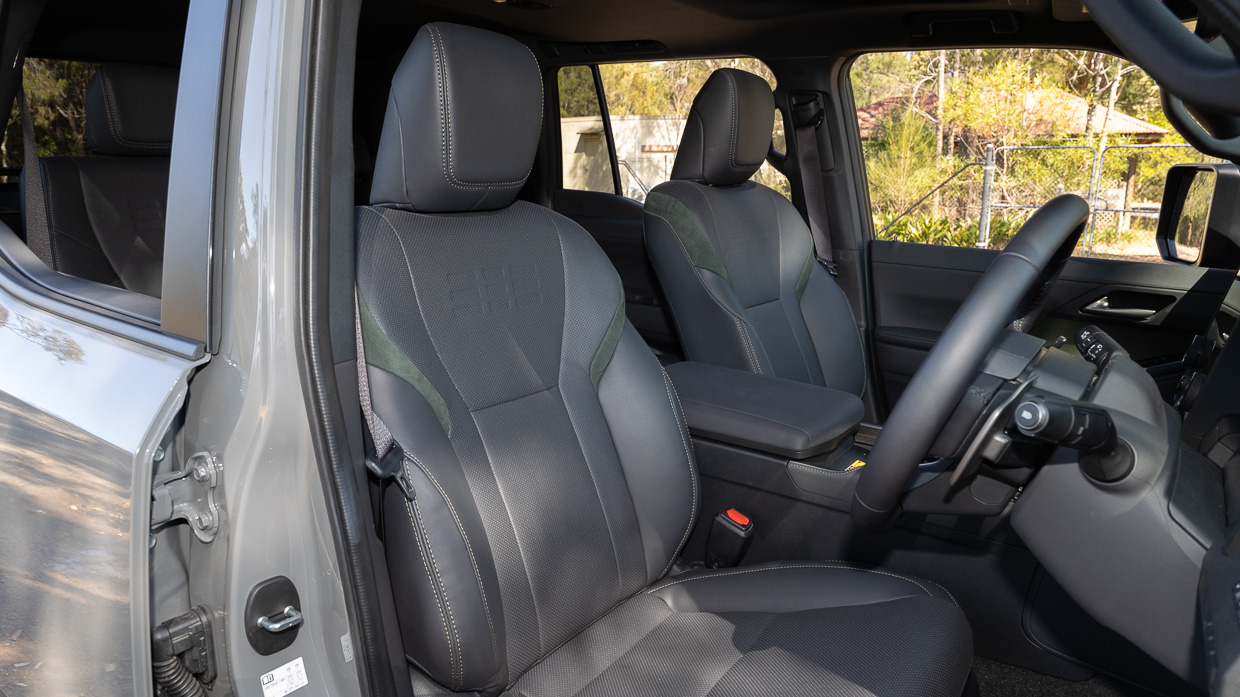
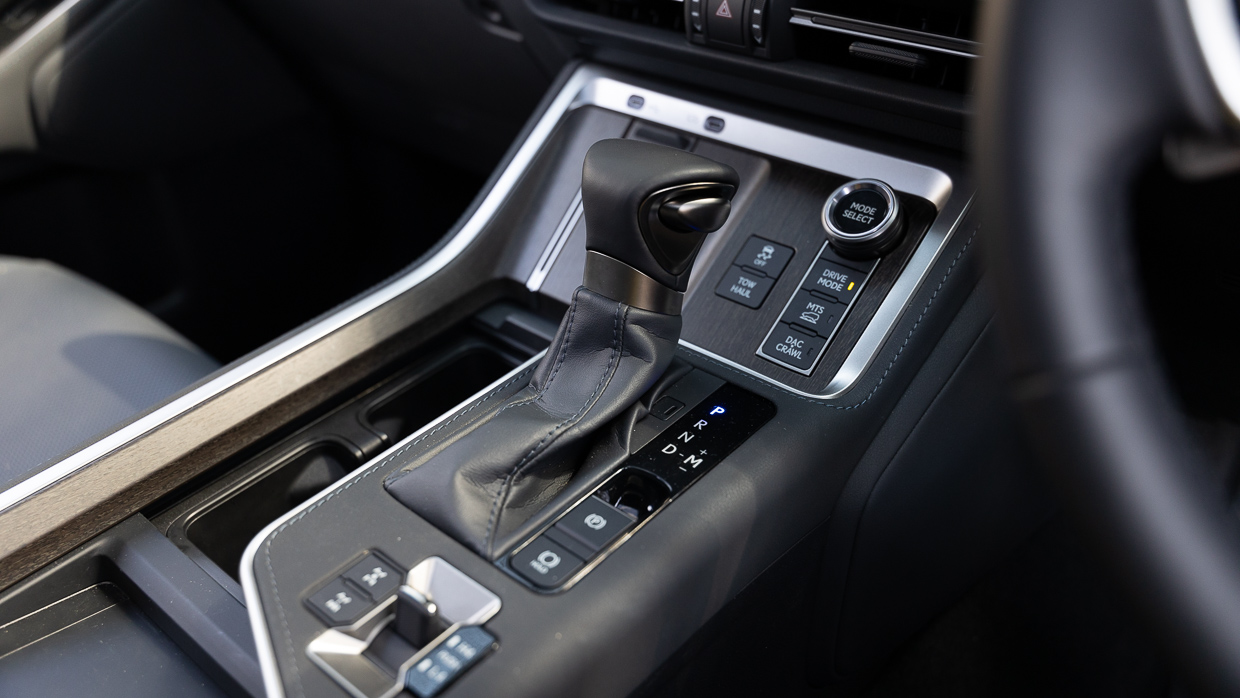
Black is fitted to the seats, dash and headliner of all GX trims. Lightening the cabin isn’t easy, though each grade offers the option of two-tone seats with black outers complemented by Dark Grey centres (Luxury), ‘Chateau’ brown centres (Overtrail), or ‘Hazel’ tan centres (Sports Luxury).
If you want a Lexus four-wheel drive dripping in light beige leather glossy burled wood, you can still have it – but only on the larger and dearer LX. The dark-theme GX, by comparison, is more youthful and broody.
The front seats of the GX (which have a stiffened base on the Overtrail only) are supportive across multi-hour driving and, for the driver, offer reasonable 10-way adjustment (including in-out lumbar). But the lack of up-down lumbar for the driver – and the total lack of lumbar adjustment for the front passenger – strike us as cheap exclusions for a car of this price.

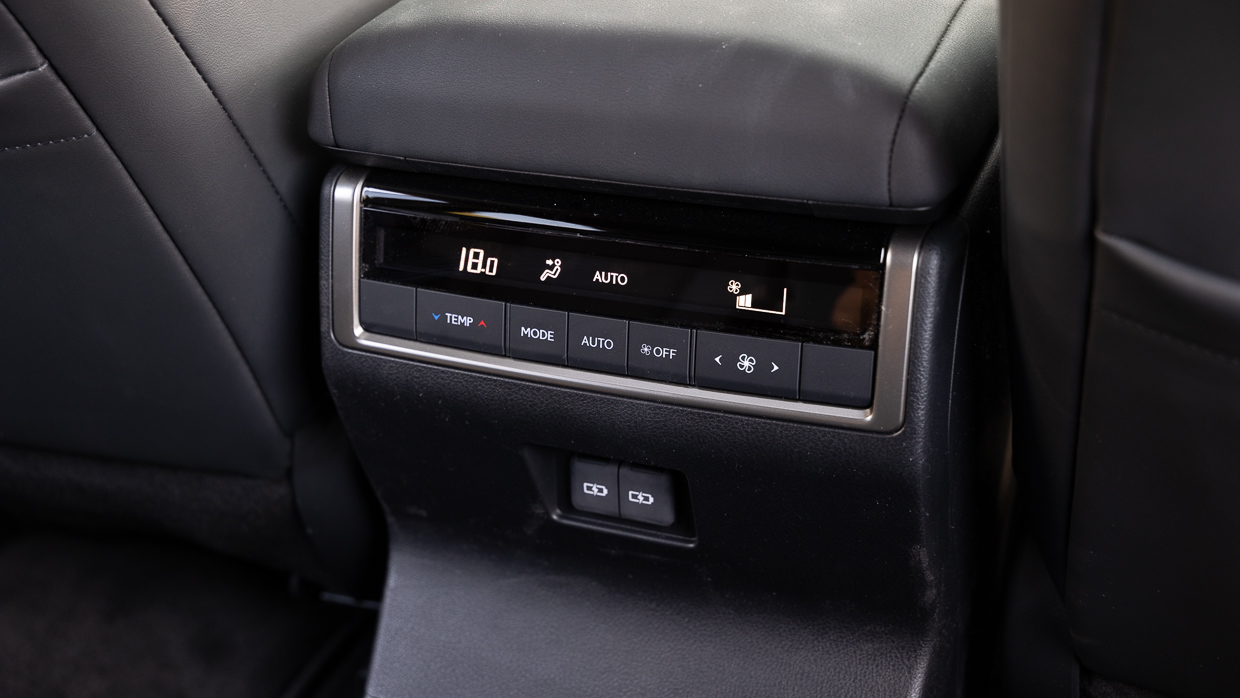
That omission joins a short list of omissions Lexus doesn’t usually forget. Also missing is keyless access for the rear doors (meaning you have to swipe a front door handle first) and rear-row sunblinds. We also find it strange you can’t option a typical Lexus enhancement pack to the Overtrail to give it, for instance, Mark Levinson audio and a digital rear mirror.
Still, the standard-fitment 10-speaker Panasonic stereo sounds remarkably decent with some tuning of the EQ, and on the whole, the Lexus infotainment system works well. We appreciate the fact that the driver’s 12.3-inch screen is inset within the dash rather than proud and cowl-less like so many newer cars.
From where we sat, the outer corners of the large 14.0-inch slate touchscreen required a bit of a stretch, and that central screen could get glary – but the menu system was intuitive and wireless Apple CarPlay (or Android Auto) paired up quickly and reliably each time. There are dials for temperature and volume but fan speed requires a touchscreen tap.
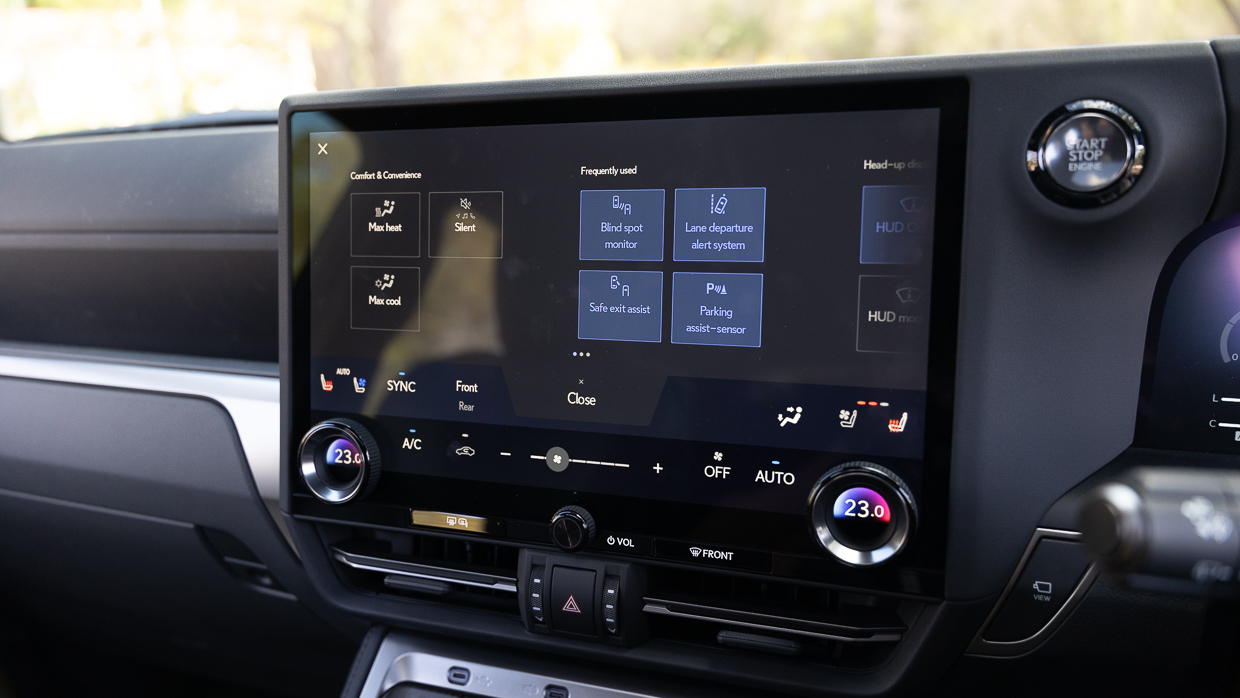
As you’d expect, the air conditioning of this Toyota Motor Corporation product is exceptionally good and cold while the Overtrail scores an effective coolbox between the seats for keeping a sandwich and a few drinks cold on a long drive.
Moving to the back seats, space is acceptable, not outstanding. Six-foot adults fit, but legroom isn’t generous, and the combination of a high floor and low seat base conspire to rob second-row passengers of leg support.
Sadly, the Overtrail can’t even be optioned as a seven-seater – meaning bigger families will have to opt for the Luxury or Sports Luxury.
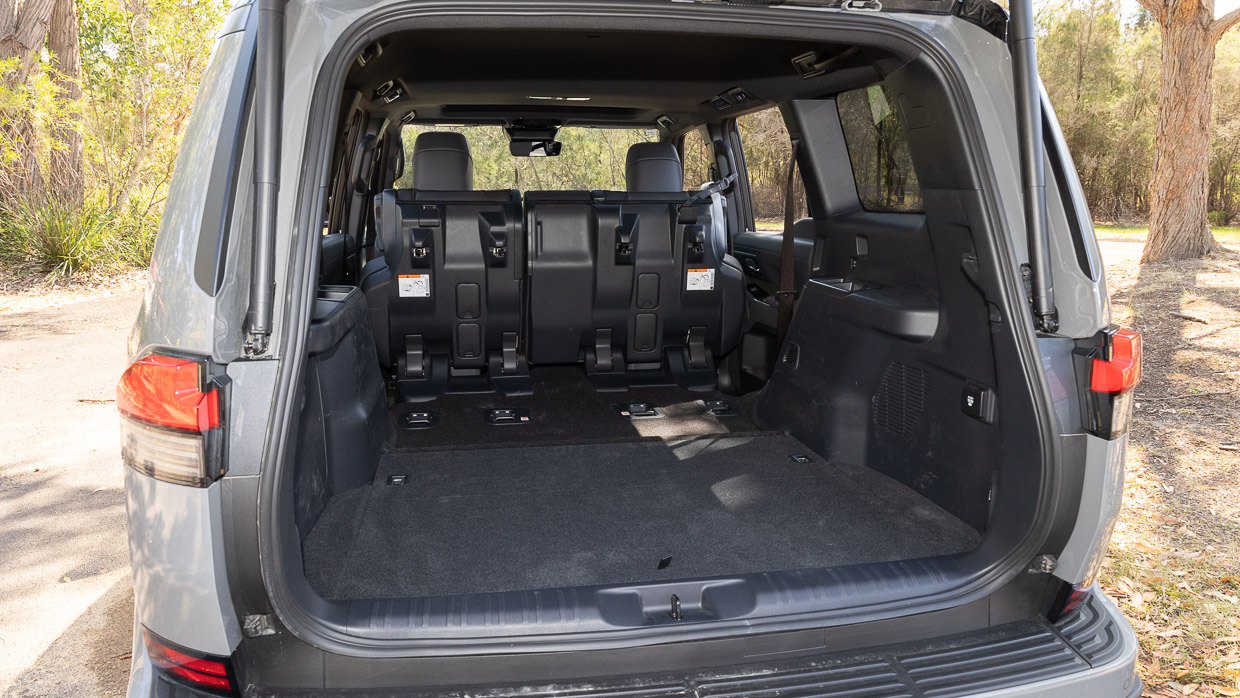
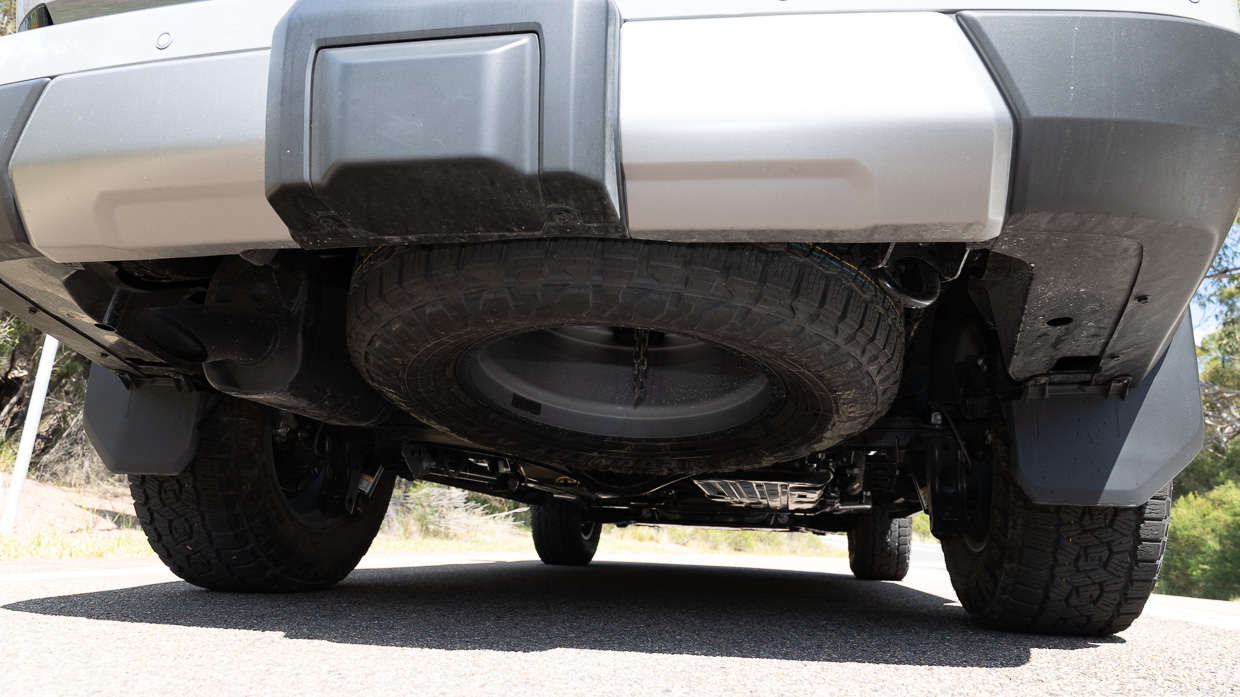
Boot-wise, we like that the tailgate glass can be opened separately to the door, allowing smaller items to be thrown in without waiting for the power liftgate to open.
Boot space is a claimed 1063 litres (VDA) behind the second row, which can also be folded to liberate 2000L. A household power point is found in the cargo area, while a full-size matching spare wheel and tyre is underslung.
Australia’s new car safety and crash testing body ANCAP has not tested the new Lexus GX. It’s not sold in Europe, and complicating matters, America’s IIHS ratings body hasn’t yet tested the vehicle either. So when it comes to objective ratings we are in the dark for the time being.
We can take some reassurance from the fact that another GA-F platform vehicle has been tested by ANCAP in-country: the Toyota Land Cruiser 300 Series, which scored five stars back in 2022. That’s not a guarantee that the GX will do the same, but it is an indicator the platform itself is up to scratch.
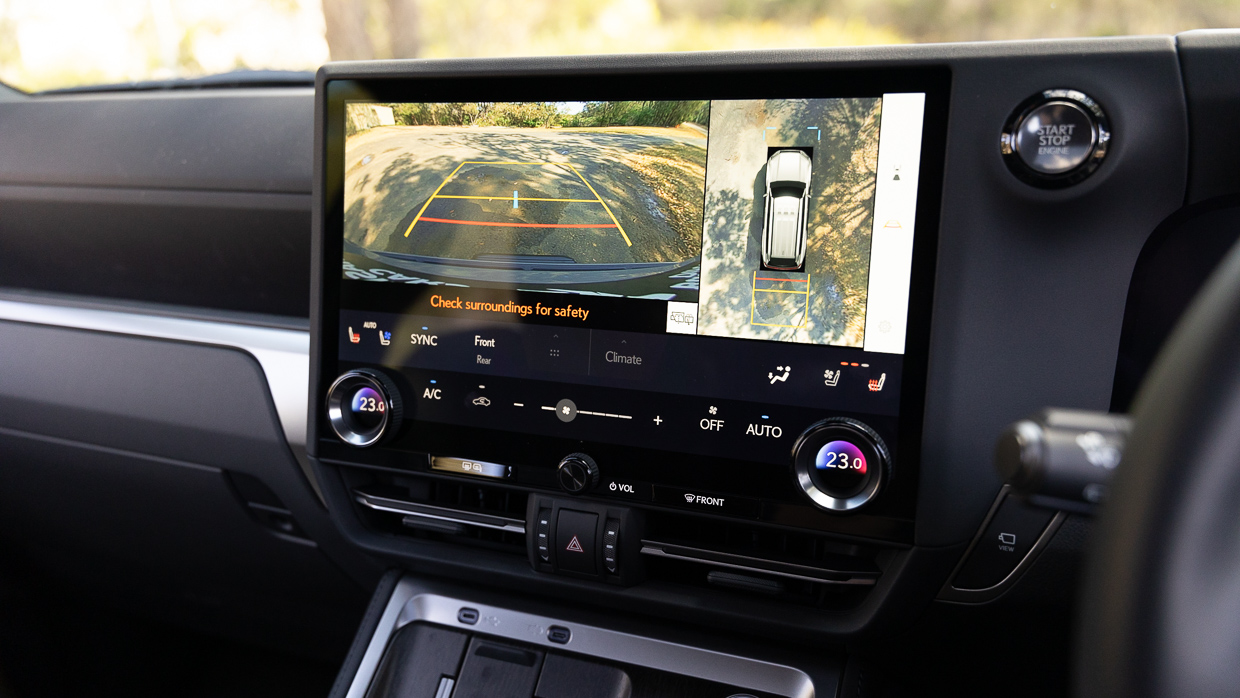
The following safety features are fitted as standard to the GX:
During our road test, we appreciated the clarity and sharpness of the 360-degree parking camera, making it easier to maneouvre the GX into parking spaces. The tuning of the adaptive cruise control was very smooth while the blind spot monitoring also worked well.
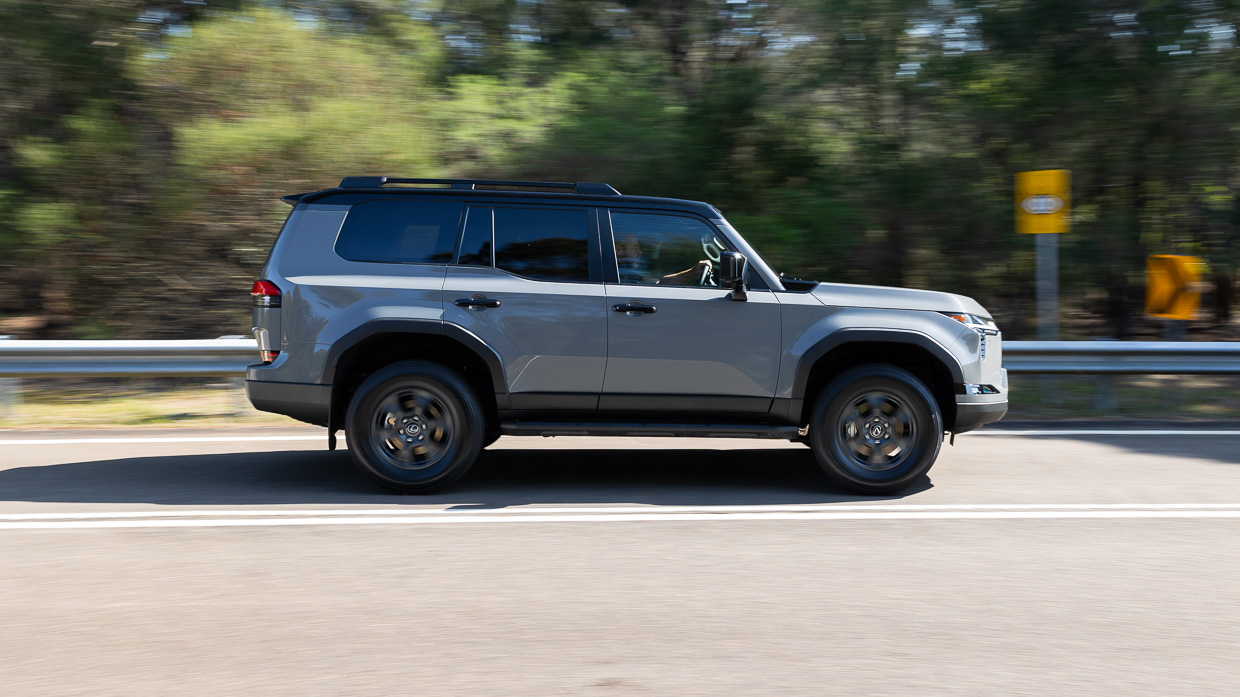
While Lexus fits lane departure warning and lane tracing assistance to the GX, like other GA-F vehicles we’ve tested, we found the tracing function had spotty functionality. The lane keeping would generally kick in as the vehicle drifted to the lane marking, and its operation was a rough. Hence, we found ourselves turning it off with two taps of the touchscreen.
The big downside to Lexus fitting a honkin’-great twin-turbo V6 petrol engine to the GX is, unsurprisingly, what it does to running costs.
To be fair, Lexus doesn’t claim that the GX550 is efficient! The claimed consumption is 12.3L/100km, and as usual, the claim is more or less achievable – but only on the open road, where we saw 12.0L/100km. In town, our result was 17.5L/100km – meaning every 100km of urban school-running (for instance) will cost a steep $40 or thereabouts in fuel.
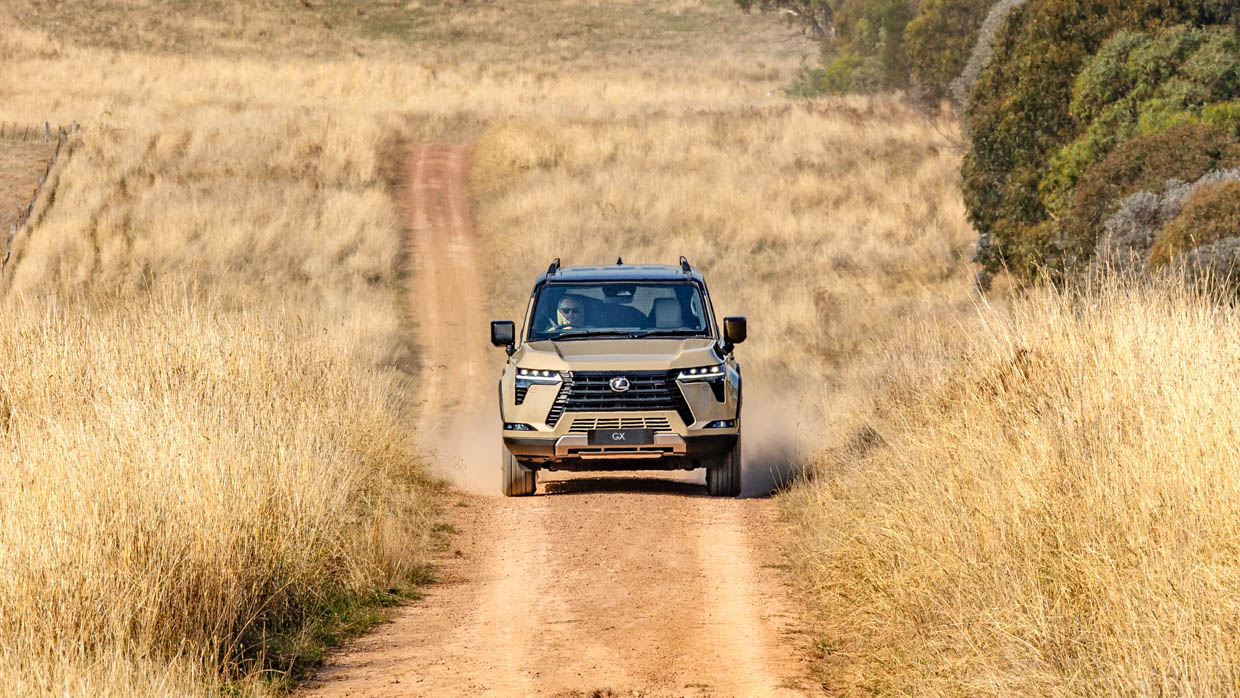
A hybrid GX is in development and will almost certainly come to Australia, but it’ll probably be the 2.4-litre turbo petrol four-cylinder parallel hybrid setup seen in the Lexus RX500h rather than a really miserly fuel-sipper.
But being costly to fuel is one thing. Being inconvenient to fuel is quite another. And the GX is – because you have to stop so often. For some reason, Lexus signed off on a small (relatively speaking) 80-litre fuel tank for the GX550, despite its prodigious thirst. Based on our tested efficiency, that means a range of 666km (highway) or 457km (urban).
It’s almost painful to think of how things might have been different had Lexus gone the extra mile and offered the company’s V6 diesel powertrain. Our experience suggests the diesel uses more like 9.0L/100km to 13.0L/100km, which would have meant a noticeably more useful range of 615km to 888km even with the same compact fuel tank.
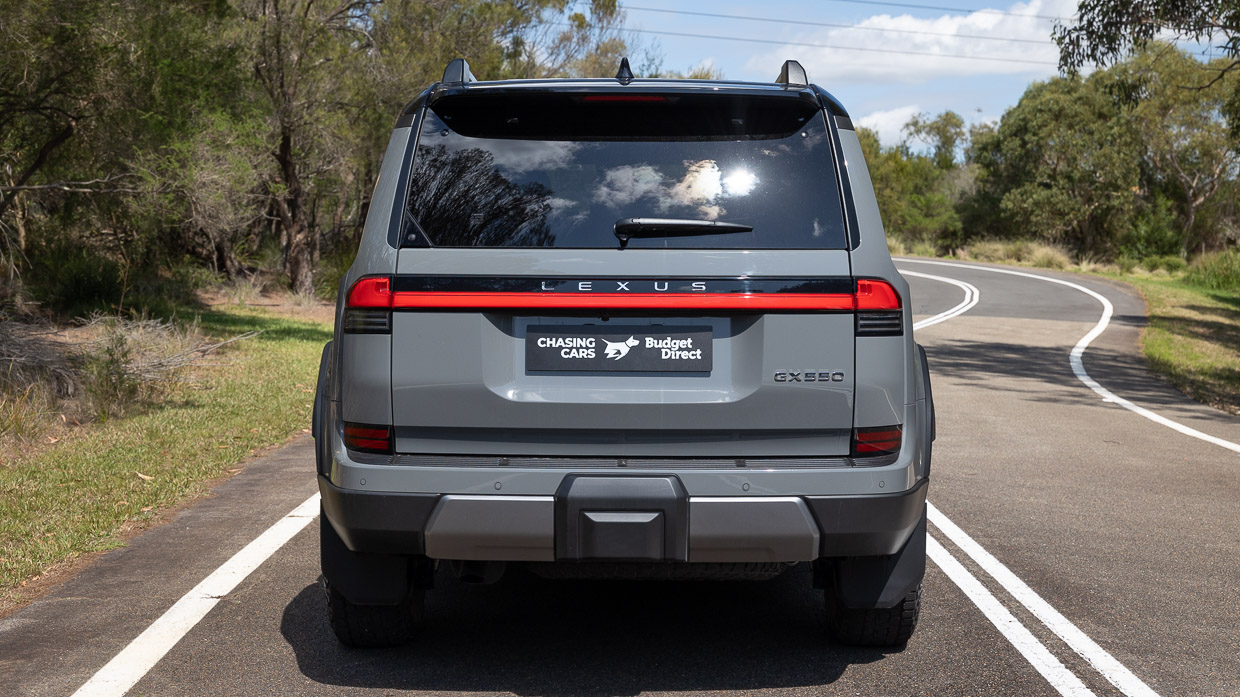
The other option would perhaps be to sell the GX with an old-school, tailgate-mounted spare wheel and tyre, opening up space for an additional fuel tank that would boost range through sheer capacity for the GX550’s required 95-octane (minimum) petrol.
On the servicing front, like other Land Cruiser products, scheduled maintenance comes up every six months or 10,000km (not annually like nearly all car-based SUVs). Lexus does cap the price of the first 10 services, resulting in a five year/100,000km total servicing cost of $5950.
Warranty for the GX is the standard five year/unlimited kilometre program offered on all Lexus vehicles.
The GX is one of the best-executed Lexus models in years. While it retains the brand’s signature premium touches, this four-wheel drive is honest, rugged and fit for purpose. It looks cool, offers solid performance, drives well, is well specified, and is based on a dependable platform and chassis.
That said, there are two clear ways Lexus could improve the GX. It could add the option of the 3.3-litre turbo V6 diesel available in the 300 Series for a peachy balance of power and efficiency. And, at the very least, it could examine ways to increase the fuel tank size to extend the paltry range of the GX550 petrol model.
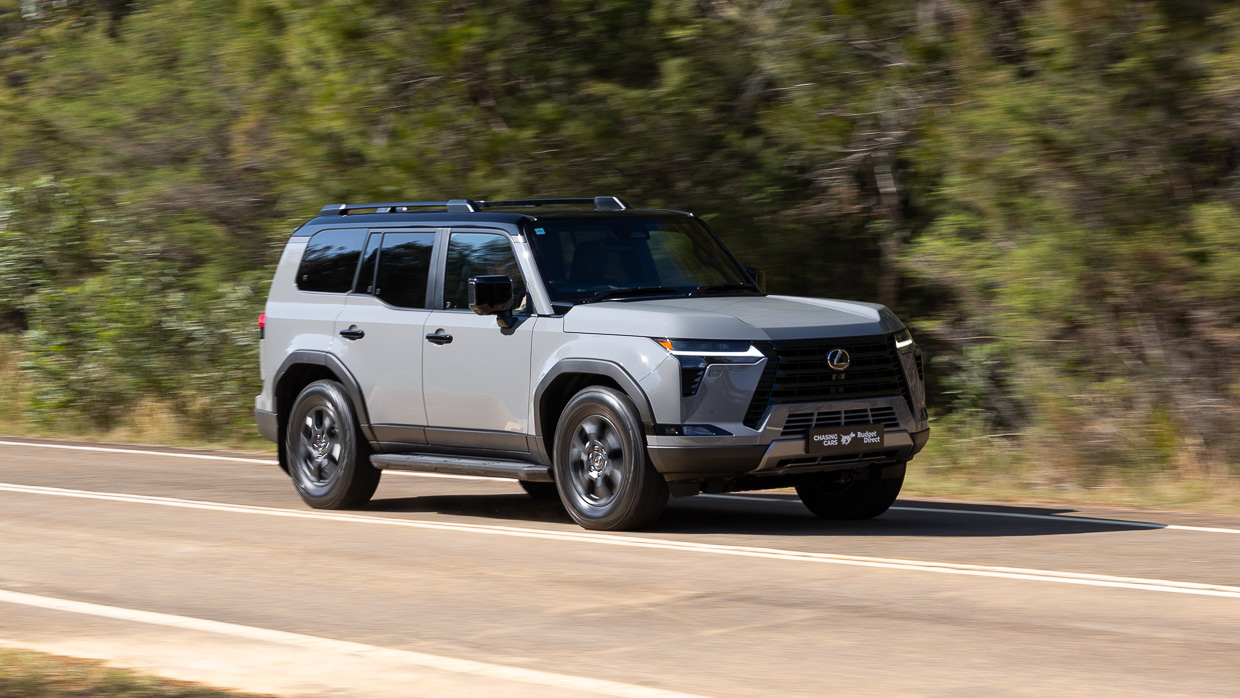
We know that Lexus is working on a turbo-petrol hybrid engine for the GX and that could be an interesting alternative, but if it were up to us, we’d keep it simple by introducing a GX500d V6 diesel.
But even if a diesel, hybrid or larger fuel tank come to fruition, we wouldn’t regard these omissions as dealbreakers. Frankly, we’d put up with the inconvenience of stopping for fuel every 600km or so – because the GX experience is so good that it’s worth the minor headache.
About Chasing cars
Chasing Cars reviews are 100% independent.
Because we are powered by Budget Direct Insurance, we don’t receive advertising or sales revenue from car manufacturers.
We’re truly independent – giving you Australia’s best car reviews.
The estimate provided does not take into account your personal circumstances but is intended to give a general indication of the cost of insurance, in order to obtain a complete quote, please visit www.budgetdirect.com.au. Estimate includes 15%^ online discount.
^Conditions Apply
Budget Direct Insurance arranged by Auto & General Services Pty Ltd ACN 003 617 909(AGS) AFSL 241 411, for and on behalf of the insurer, Auto & General Insurance Company Limited(ABN 42 111 586 353, AFSL 285 571).Because we don’t know your financial needs, we can’t advise you if this insurance will suit you. You should consider your needs and the Product Disclosure Statement before making a decision to buy insurance. Terms and conditions apply.
Indicative quote based on assumptions including postcode , 40 year old male with no offences, licence suspensions or claims in the last 5 years, a NCD Rating 1 and no younger drivers listed. White car, driven up to 10,000kms a year, unfinanced, with no modifications, factory options and/or non-standard accessories, private use only and garaged at night.
^Online Discounts Terms & Conditions
1. Discounts apply to the premium paid for a new Budget Direct Gold Comprehensive Car Insurance, Third Party Property Only or Third Party Property, Fire & Theft Insurance policy initiated online on or after 29 March 2017. Discounts do not apply to optional Roadside Assistance.
2. Discounts do not apply to any renewal offer of insurance.
3. Discounts only apply to the insurance portion of the premium. Discounts are applied before government charges, taxes, levies and fees, including instalment processing fees (as applicable). The full extent of discounts may therefore be impacted.
4. We reserve the right to change the offer without notice.